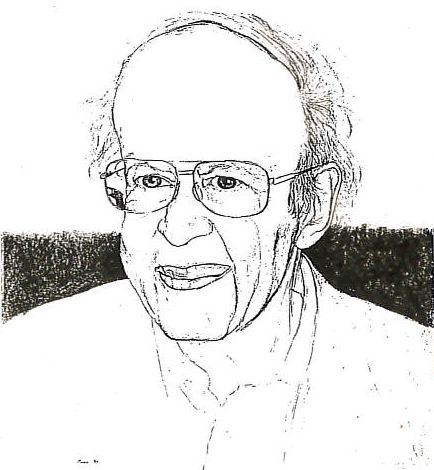
Meeting report
Hodgkin Retrospective
 Max Perutz at the Hodgkin Retrospective (sketch by Julia Duax).
Max Perutz at the Hodgkin Retrospective (sketch by Julia Duax).
On July 12, 1996 the British Crystallographic Association organized a meeting at the Royal Society to mark the publication of Dorothy Hodgkin's collected papers by the Indian Academy of Science. The meeting was planned by S. Ramaseshan, J. Howard and G. Dodson to provide an opportunity to review the current state of research areas to which Dorothy had made primary contributions. Topics included cholesterol, penicillin, Vitamin B12, pepsin-related enzymes and insulin, as well as current and future developments in crystallography. The papers spanned her scientific career from 1935 to 1989. Their importance lies in their crystallographic originality, and the fact that they changed the way that chemists thought, and signalled the importance of structural knowledge to chemistry and biology. D. Blow surveyed the early Crowfoot and Bernal studies of sterol crystals. The penicillin session was devoted to a discussion of the crystal structure of isopenicillin N synthase determined in Oxford. The exciting new structure of methyl malonyl CoA-mutase was described by P. Evans. It requires the co-factor adenosyl-cobalamin and generates a free radical in its mechanism of action. J. Glusker presented ab initio molecular orbital data on the free radical rearrangement that occurs in another B12 utilizing enzyme. In 1934 Dorothy and J. D. Bernal reported in Nature the first X-ray diffraction pattern obtained from a protein , pepsin. T. Blundell looked at the aspartic proteinase family whose members are present in a wide variety of organisms and some of which, most notably HIV protease and renin, are targets for structure-based drug design. When Dorothy went to Oxford she began research into insulin's structure, that structure determination led to the design of mutant insulins now used in diabetic therapy. G. Dodson discussed how structural knowledge is being applied to the phenomenon of insulin fibril formation. J. Dunitz gave an overview of what crystallography has contributed to chemistry, biochemistry, and physics. M. Rossman summarised the state of the macromolecular field. He foresees the subject becoming increasingly rigorous and driven by molecular biologists. M. Perutz commented on the challenges facing scientists in the 1930's compared with those of the 1990's. He felt that the problems he and Dorothy faced were simpler - they knew that if they had better techniques their problems could be solved, whereas now more knowledge is not leading to simplification, if anything the reverse.
Eleanor Dodson


